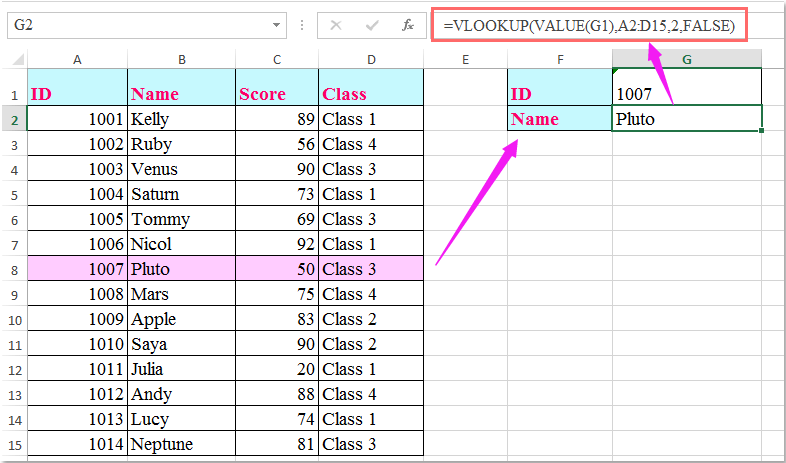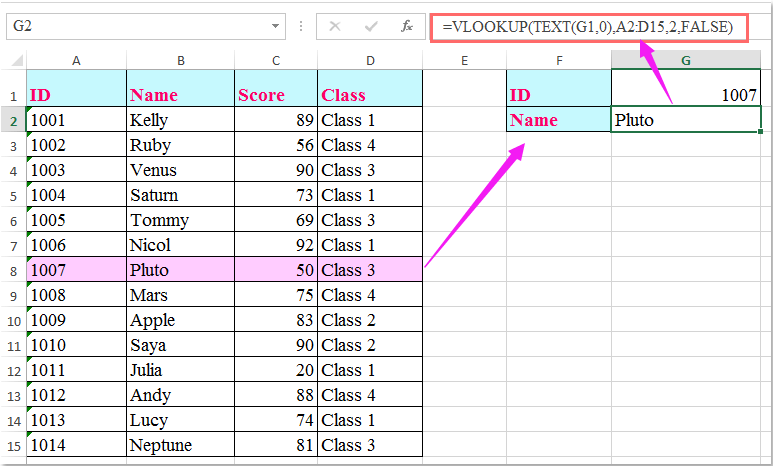วิธีการจัดเก็บหมายเลข vlookup เป็นข้อความใน Excel
สมมติว่าฉันมีช่วงข้อมูลต่อไปนี้หมายเลข ID ในตารางต้นฉบับเป็นรูปแบบตัวเลขในเซลล์การค้นหาซึ่งจัดเก็บเป็นข้อความเมื่อฉันใช้ฟังก์ชัน VLOOKUP ปกติฉันจะได้รับผลลัพธ์ข้อผิดพลาดดังภาพด้านล่างที่แสดง ในกรณีนี้ฉันจะได้รับข้อมูลที่ถูกต้องได้อย่างไรหากหมายเลขการค้นหาและหมายเลขเดิมในตารางมีรูปแบบข้อมูลที่แตกต่างกัน
หมายเลข Vlookup ที่จัดเก็บเป็นข้อความพร้อมสูตร

 หมายเลข Vlookup ที่จัดเก็บเป็นข้อความพร้อมสูตร
หมายเลข Vlookup ที่จัดเก็บเป็นข้อความพร้อมสูตร
หากหมายเลขการค้นหาของคุณถูกจัดเก็บเป็นข้อความและหมายเลขเดิมในตารางเป็นรูปแบบจำนวนจริงโปรดใช้สูตรต่อไปนี้เพื่อส่งคืนผลลัพธ์ที่ถูกต้อง:
ใส่สูตรนี้: = VLOOKUP (ค่า (G1), A2: D15,2, FALSE) ลงในเซลล์ว่างที่คุณต้องการค้นหาผลลัพธ์แล้วกด เข้าสู่ คีย์เพื่อส่งคืนข้อมูลที่เกี่ยวข้องที่คุณต้องการดูภาพหน้าจอ:

หมายเหตุ:
1. ในสูตรข้างต้น: G1 เป็นเกณฑ์ที่คุณต้องการค้นหา A2: D15 คือช่วงของตารางที่มีข้อมูลที่คุณต้องการใช้และตัวเลข 2 ระบุหมายเลขคอลัมน์ที่มีค่าสอดคล้องกันที่คุณต้องการส่งคืน
2. หากค่าการค้นหาของคุณเป็นรูปแบบตัวเลขและหมายเลข ID ในตารางเดิมถูกจัดเก็บเป็นข้อความสูตรด้านบนจะใช้ไม่ได้คุณควรใช้สูตรนี้: = VLOOKUP (ข้อความ (G1,0), A2: D15,2, FALSE) เพื่อให้ได้ผลลัพธ์ที่ถูกต้องตามที่คุณต้องการ

3. หากคุณไม่แน่ใจว่าคุณจะมีตัวเลขและข้อความเมื่อใดคุณสามารถใช้สูตรนี้: =IFERROR(VLOOKUP(VALUE(G1),A2:D15,2,0),VLOOKUP(TEXT(G1,0),A2:D15,2,0)) เพื่อจัดการทั้งสองกรณี
สุดยอดเครื่องมือเพิ่มผลผลิตในสำนักงาน
เพิ่มพูนทักษะ Excel ของคุณด้วย Kutools สำหรับ Excel และสัมผัสประสิทธิภาพอย่างที่ไม่เคยมีมาก่อน Kutools สำหรับ Excel เสนอคุณสมบัติขั้นสูงมากกว่า 300 รายการเพื่อเพิ่มประสิทธิภาพและประหยัดเวลา คลิกที่นี่เพื่อรับคุณสมบัติที่คุณต้องการมากที่สุด...

แท็บ Office นำอินเทอร์เฟซแบบแท็บมาที่ Office และทำให้งานของคุณง่ายขึ้นมาก
- เปิดใช้งานการแก้ไขและอ่านแบบแท็บใน Word, Excel, PowerPoint, ผู้จัดพิมพ์, Access, Visio และโครงการ
- เปิดและสร้างเอกสารหลายรายการในแท็บใหม่ของหน้าต่างเดียวกันแทนที่จะเป็นในหน้าต่างใหม่
- เพิ่มประสิทธิภาพการทำงานของคุณ 50% และลดการคลิกเมาส์หลายร้อยครั้งให้คุณทุกวัน!
